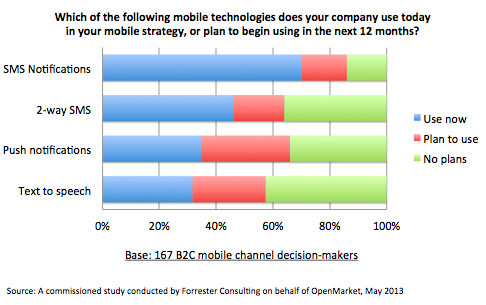Today, massive excitement is building around universal, open Internet connectivity. With the establishment of high-profile global projects like Facebook’s Internet.org, incalculable social and economic gains seem just at the horizon. For developers, too, that means the rapid multiplication of new opportunities for the deployment of the best tools for driving innovation and connectivity all over the planet. But the Internet isn’t the only technology driving innovation and connectivity, especially when it comes to mobile.
A recent count put the number of mobile devices in the world at 7 billion—which is to say that the Age of the Internet is now also the Age of Mobile. SMS works on essentially all 7 billion of these devices, from smartphones to the ubiquitous feature phones of the developing world. Simply put, SMS texting is still the single most common use of all mobile devices anywhere—and use cases for SMS continue to multiply.
One could say that SMS works so well it has become almost invisible. Even while Internet access and smartphones continue to spread, and as Internet-based messaging apps like WhatsApp proliferate, SMS is still changing the way we communicate, travel, organize our lives, and run our businesses. It has played a quiet, crucial role in some of the most disruptive endeavors of the last few years: Twitter’s system of 140-character status updates was born out of SMS. Urban transportation startup Uber has SMS functionality baked into its smartphone applications, as do more and more popular smartphone apps ranging from food apps like Sprig to dating apps like CoffeeMeetsBagel.
A 2013 study by Forrester of 167 mobile-channel businesses found that 70% are already using SMS notifications, with another 16% planning to use SMS notifications in the next year. Similarly, 46% of businesses in the study already use two-way SMS, with another 18% planning to add two-way SMS in the next year.
Why is SMS still becoming more popular for businesses despite the continuing spread of internet access and smartphones?
As Steve French explains in a post on Wired.com, many companies that joined the smartphone app frenzy in the past few years are realizing that their new mobile app isn’t getting enough usage to justify the resources needed to build and maintain it. As a result, companies are now moving resources back to SMS—which is ubiquitous, interoperable, easy to use, affordable, and immediate. SMS also results in results in better customer engagement. Text messages have the highest open rate of any digital communication medium at 97%, compared to only 20-25% for email.
In the developing world, SMS is also continuing to spur innovation—not least because it can go places the Internet can’t. SMS-capable feature phones are perfect for regions without reliable electricity or the bandwidth to support a data-hungry smartphone. Because smartphones and laptops don’t yet dominate the technology landscape in developing countries, SMS solutions have jumped further forward than they might have in countries with fully developed Internet infrastructure.
But even as smartphones and internet access spreads around the world and as new communication apps like WhatsApp, Facebook Messenger, and WeChat proliferate, those apps will only ever reach a fraction of mobile users. It’s likely that no single messaging app will win the market globally. As a result, SMS will remain the most ubiquitous technology that organizations and businesses can use to communicate with anyone.
SMS will play a crucial role in connecting us, fostering economic growth and our efforts to strengthen education, human rights, and global health. In conjunction with the Internet, it will continue to structure the life and work of people around the world. The best days of SMS are still ahead.
